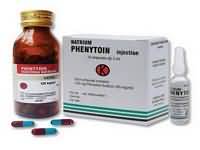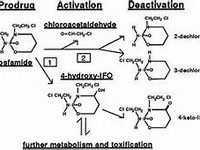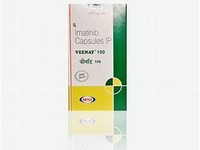Phenytoin

CLINICAL USE
Anti-epileptic agent Diabetic neuropathy Trigeminal neuralgia
DOSE IN NORMAL RENAL FUNCTION
Oral: 150–500 mg/day or 3–4 mg/kg/day in 1–2 divided doses; higher doses can be used in exceptional casesStatus epilepticus (IV): 10–18 mg/kg (with BP and ECG monitoring) then 100 mg every 6–8 hours according to levels
PHARMACOKINETICS
Molecular weight :252.3 (274.2 as sodium salt) %Protein binding :90 %Excreted unchanged in urine : up to 5 Volume of distribution (L/kg) :0.52–1.19half-life – normal/ESRD (hrs) :7–42/ Unchanged DOSE IN RENAL IMPAIRMENT
GFR (mL/MIN)
20 to 50 : Dose as in normal renal function 10 to 20 : Dose as in normal renal function <10 : Dose as in normal renal function DOSE IN PATIENTS UNDERGOING RENAL REPLACEMENT THERAPIES
CAPD :Not dialysed. Dose as in normal renal function HD :Not dialysed. Dose as in normal renal functionHDF/high flux :Dialysed. Dose as in normal renal function. CAV/VVHD :Unknown dialysability. Dose as in normal renal function IMPORTANT DRUG INTERACTIONS
Potentially hazardous interactions with other drugsAnalgesics: enhanced effect with NSAIDs; metabolism of methadone acceleratedAnti-arrhythmics: increased concentration with amiodarone; concentration of disopyramide and mexiletine reducedAntibacterials: level increased by clarithromycin, chloramphenicol, isoniazid, metronidazole, co-trimoxazole and trimethoprim (+ antifolate effect); concentration increased or decreased by ciprofloxacin; concentration of doxycycline and telithromycin reduced; concentration reduced by rifampicinAnticoagulants: increased metabolism of coumarins (reduced effect but also reports of enhancement)Antidepressants: MAOIs, SSRIs and tricyclics antagonise anticonvulsant effect, concentration increased by fluoxetine and fluvoxamine; concentration of mianserin, mirtazepine and paroxetine and possibly tricyclics reduced; concentration reduced by St John’s wort – avoidAnti-epileptics: concentration of both drugs reduced with carbamazepine, concentration may also be increased by carbamazepine, ethosuximide, oxcarbazepine and topiramate; concentration of ethosuximide, active oxcarbazepine metabolite, primidone (but active metabolite increased), topiramate and valproate possibly reduced; concentration of lamotrigine, tiagabine and zonisamide reduced; primidone and valproate may alter concentration; concentration reduced by vigabatrin Antifungals: concentration of ketoconazole, itraconazole, posaconazole, voriconazole and possibly caspofungin reduced – avoid with itraconazole, increase voriconazole dose and possibly caspofungin; levels increased by fluconazole, miconazole and voriconazoleAntimalarials: antagonise anticonvulsant effect; increased antifolate effect with pyrimethamineAntipsychotics: antagonise anticonvulsant effect; possibly reduced aripiprazole concentration – increase aripiprazole dose; metabolism of clozapine, quetiapine and sertindole increased Calcium-channel blockers: levels increased by diltiazem; concentration of diltiazem, felodipine, isradipine, nisoldipine and verapamil and possibly dihydropyridines, nicardipine and nifedipine reducedCiclosporin: reduced ciclosporin levels Corticosteroids: metabolism accelerated (effect reduced)Cytotoxics: metabolism inhibited by fluorouracil; increased antifolate effect .582 PHeNYtOINto avoid irritation. Cardiac monitoring recommended OTHER INFORMATION
Aim for phenytoin levels of 10 to 20 : mg/L (40–80 micromol/L)Total phenytoin levels must be adjusted for hypoalbuminaemia and uraemia (levels of 5–12 mcg/mL may be enough)Decreased protein binding and volume of distribution in renal failureFree fraction of phenytoin is increased in uraemia to approximately 0.2Request free phenytoin serum levels, if possibleLoading dose 15 mg/kg IV or oral, then 5 mg/kg/day. Steady state reached in 3–5 days if loading dose givenIncrease dose gradually (25–50 mg/day at weekly intervals); demonstrates saturation kineticsPhenytoin absorption is markedly reduced by concurrent nasogastric enteral nutrition administration. Avoid concomitant administration with divalent cationsMay cause folate deficiency A useful equation: To correct a phenytoin level for low albumin: from Winters ME. Basic Clin Pharmacokinet, 3rd ed. Philadelphia PA. Lippincott Williams & Wilkins; 1994Cnormal Cobserved{(0.48) × (1 0.1) × albumin} + 0.1 4.4(g/dl)with methotrexate; reduced phenytoin absorption; concentration of busulfan, etoposide and imatinib reduced – avoid with imatinibDisulfiram: levels of phenytoin increased Diuretics: concentration of eplerenone reduced – avoid concomitant use; increased risk of osteomalacia with carbonic anhydrase inhibitors; antagonises effect of furosemideOestrogens and progestogens: metabolism increased (reduced contraceptive effect)Sulfinpyrazone: concentration increased by sulfinpyrazoneTheophylline: concentration of both drugs reduced Ulcer-healing drugs: metabolism inhibited by cimetidine; absorption reduced by sucralfate; enhanced effect with esomeprazole and omeprazole ADMINISTRATION
Reconstition
– Route
IV, oral Rate of Administration
IV infusion
and bolus: not greater than 50 mg/minuteComments
Infusion: dilute in 50–100 mL sodium chloride 0.9%; final concentration not exceeding 10 mg/mLGive by slow IV injection into large vein followed by sodium chloride 0.9% flush,
See how to identify renal failure stages according to GFR calculation
See how to diagnose irreversible renal disease
Home









